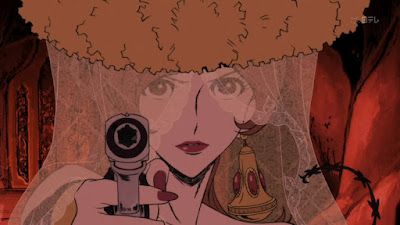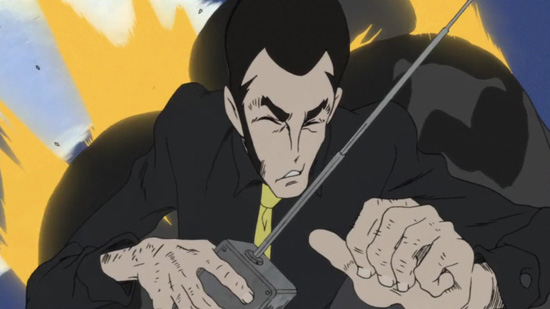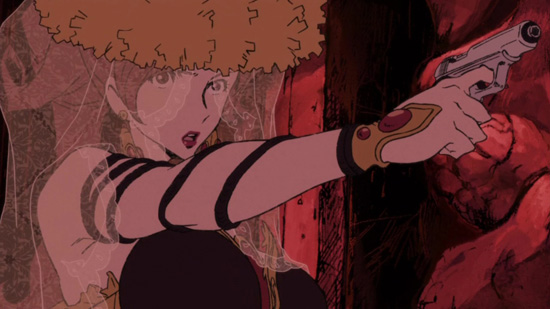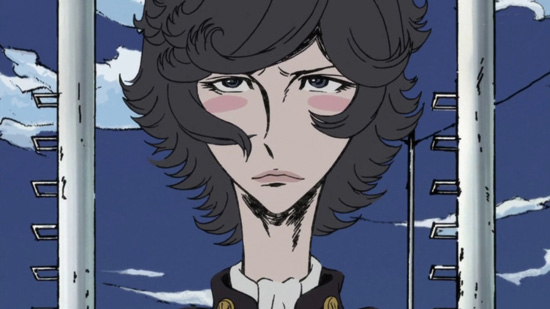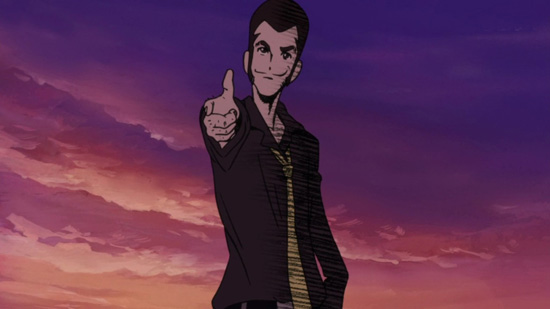
And with the first two episodes of Lupin III: Fujiko Mine, fans of the master thief have been treated to a visually astonishing, moody, and yet wholly reverent take on Monkey Punch’s classic characters. Sporting animation direction by Takeshi Koike (REDLINE) and head series direction by Sayo Yamamoto (Michiko To Hatchin), this is the kind of television event that is far more than a single AD commentator can handle, so join ElectricV01 and I as we parse through the show in progress!
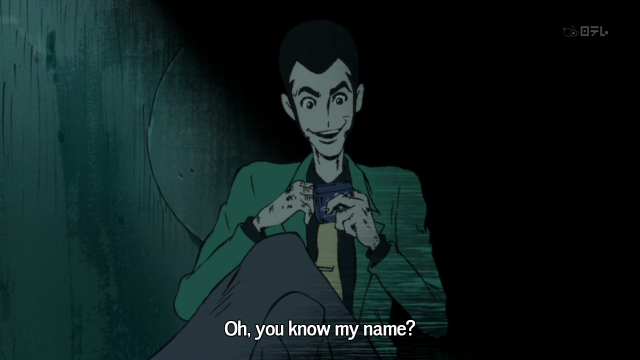
Episode 1: Master Thief Vs. Lady Looter
 Wintermuted: I’m
going to open by saying that before I laid my eyes on this project, I
had zero clue about what to expect. But right off the bat, when I saw
the names behind it, I immediately grew excited. I was also caught off
guard by the opening credits that seemed to imply a little more
internalization than is normal for a Lupin III production. Happily,
certain fears were dashed upon seeing the first few shots of this
rendition of how Lupin met Fujiko, and how it retained so much of what I
enjoy about a good Lupin caper. What were your impressions of this
first encounter as a start?
Wintermuted: I’m
going to open by saying that before I laid my eyes on this project, I
had zero clue about what to expect. But right off the bat, when I saw
the names behind it, I immediately grew excited. I was also caught off
guard by the opening credits that seemed to imply a little more
internalization than is normal for a Lupin III production. Happily,
certain fears were dashed upon seeing the first few shots of this
rendition of how Lupin met Fujiko, and how it retained so much of what I
enjoy about a good Lupin caper. What were your impressions of this
first encounter as a start? ElectricV01: Well,
like you I wasn’t sure what to expect. There was no real trailer for
the new series to speak of, so the entire visual style caught me off
guard. It’s such a departure visually from everything else we have seen
of Lupin in the past 30 years, and I love it. It looks as if Monkey
Punch drew it himself. The character designs and the sketchy animation
style hearken back to those original comics from the 60s. And after
watching the first episode, I knew this series was going to be something
special. It’s got just the perfect amount of nostalgic fun for the old
school Lupin fan, while keeping everything new and exciting. This seems
like the perfect place for people curious what Lupin is all about to
jump on board. They tell you everything you need to know right there in
episode one.
ElectricV01: Well,
like you I wasn’t sure what to expect. There was no real trailer for
the new series to speak of, so the entire visual style caught me off
guard. It’s such a departure visually from everything else we have seen
of Lupin in the past 30 years, and I love it. It looks as if Monkey
Punch drew it himself. The character designs and the sketchy animation
style hearken back to those original comics from the 60s. And after
watching the first episode, I knew this series was going to be something
special. It’s got just the perfect amount of nostalgic fun for the old
school Lupin fan, while keeping everything new and exciting. This seems
like the perfect place for people curious what Lupin is all about to
jump on board. They tell you everything you need to know right there in
episode one. Wintermuted:
Oh, for sure. The complete palette on display from the very opening
credits were surprising to say the least. And upon considering the names
behind it, I’d throw in that this is an all-star production, featuring
talents who in many ways have prepped for a project like this their
entire careers. And boy, is it an out of the gate labor of love.
Wintermuted:
Oh, for sure. The complete palette on display from the very opening
credits were surprising to say the least. And upon considering the names
behind it, I’d throw in that this is an all-star production, featuring
talents who in many ways have prepped for a project like this their
entire careers. And boy, is it an out of the gate labor of love.Much like what you said, the first episode is something of a typical Lupin adventure, albeit with a truly unique and evocative style reminiscent of the Monkey Punch comics. They even went so far as to mimic printing imperfections! Something I was not expecting at all, considering that this is the first time we’ve got a series that makes Fujiko the center of our story. (She’s a character I’ve always found to be the most complex/realistic of the bunch.) Any thoughts on how they treated the dynamic between her and Lupin’s first meeting?
 ElectricV01:
I thought it was pretty spot on, sowing the seeds of one of the most
famous rivalries in anime. Lots of people tend to forget Fujiko and
Lupin spend just as much time against each other as they do working as a
team, and here we get to see how that started brewing. Fujiko obviously
already thinks she is a rival to the greatest thief in the world, and
Lupin just kinda smirks and wonders what this new gorgeous challenge is
really after. And they learn a lot about each other in this first
outing: things like how Fujiko will kill people, and Lupin will not.
Which is interesting as that is more in step with earlier animated
versions of his character. As this show more resembles the manga in
style, I was kinda expecting something of a return of the more ruthless
Lupin from the original comic where he killed people left and right.
ElectricV01:
I thought it was pretty spot on, sowing the seeds of one of the most
famous rivalries in anime. Lots of people tend to forget Fujiko and
Lupin spend just as much time against each other as they do working as a
team, and here we get to see how that started brewing. Fujiko obviously
already thinks she is a rival to the greatest thief in the world, and
Lupin just kinda smirks and wonders what this new gorgeous challenge is
really after. And they learn a lot about each other in this first
outing: things like how Fujiko will kill people, and Lupin will not.
Which is interesting as that is more in step with earlier animated
versions of his character. As this show more resembles the manga in
style, I was kinda expecting something of a return of the more ruthless
Lupin from the original comic where he killed people left and right. Wintermuted: It
was a very interesting choice to make this caper one to not only set up
this complicated er-relationship, but to also delve into places they
are willing/not willing to go. What this does for me is offer something
of a broad slate with which newer viewers may be able to better
understand where the classic Lupin comes from. And seeing just how over
the top this first caper with the false prophet is, perhaps what it
implies is how much more dangerous Fujiko actually is. In classic
superhero fashion, this may set up events to come down the line, making
Lupin into something much less hopelessly selfish. This, or make him
look at darker elements of his psyche, which is something that is often
sidestepped for wacky action. (Not that the first episode is short on
this in any respect.) Lupin may be playing with some serious fire this
time..
Wintermuted: It
was a very interesting choice to make this caper one to not only set up
this complicated er-relationship, but to also delve into places they
are willing/not willing to go. What this does for me is offer something
of a broad slate with which newer viewers may be able to better
understand where the classic Lupin comes from. And seeing just how over
the top this first caper with the false prophet is, perhaps what it
implies is how much more dangerous Fujiko actually is. In classic
superhero fashion, this may set up events to come down the line, making
Lupin into something much less hopelessly selfish. This, or make him
look at darker elements of his psyche, which is something that is often
sidestepped for wacky action. (Not that the first episode is short on
this in any respect.) Lupin may be playing with some serious fire this
time..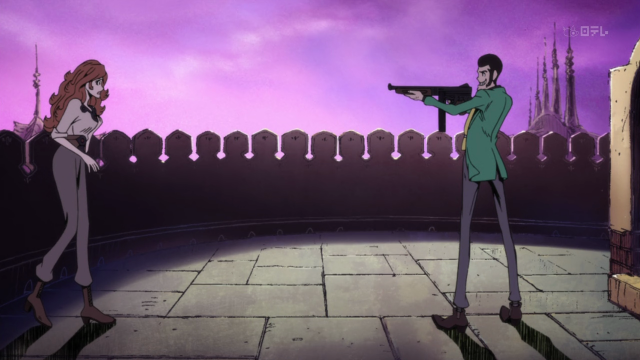
 ElectricV01: Right,
and that also plays in the style of the original manga. It had lots of
wacky, almost MAD magazine style zaniness, but was still quite dark.
Betrayal, death, suicide were all commonplace in the manga. Some of
this was touched on in the original “green jacket series” but I think it
would be really interesting to see this darkness played with more in
the storylines of this new series. Still, I’m glad they’re not straying
too far from the character’s personalities as they have been portrayed
over the past 40 years. If you are a Lupin fan, you can watch this and
go ,”Yep, that’s Lupin. Yep, that’s Fujiko.” And that is great.
ElectricV01: Right,
and that also plays in the style of the original manga. It had lots of
wacky, almost MAD magazine style zaniness, but was still quite dark.
Betrayal, death, suicide were all commonplace in the manga. Some of
this was touched on in the original “green jacket series” but I think it
would be really interesting to see this darkness played with more in
the storylines of this new series. Still, I’m glad they’re not straying
too far from the character’s personalities as they have been portrayed
over the past 40 years. If you are a Lupin fan, you can watch this and
go ,”Yep, that’s Lupin. Yep, that’s Fujiko.” And that is great. Wintermuted: Yeah,
ending it with Fujiko accidentally getting a little stoned, and then
leaving with a classic Lupin note as she failed to notice him leaving
was a sweet way to round out the first episode. It’s immediately the
classic “style vs. cunning” dynamic. (Recurring motif: This is Sayo
Yamamoto’s second directorial effort, and her second time featuring a
lead character taking off on a sweet bike. Like I mentioned before,
primed to work on a series like this.)
Wintermuted: Yeah,
ending it with Fujiko accidentally getting a little stoned, and then
leaving with a classic Lupin note as she failed to notice him leaving
was a sweet way to round out the first episode. It’s immediately the
classic “style vs. cunning” dynamic. (Recurring motif: This is Sayo
Yamamoto’s second directorial effort, and her second time featuring a
lead character taking off on a sweet bike. Like I mentioned before,
primed to work on a series like this.) ElectricV01: Well,
motorcycles and Fujiko aren’t exactly a new concept… She’s been a biker
since the first series. It’s really become an iconic part of her
character, riding off on her bike at the end of each episode or movie.
So it was another nice tie into the original series.
ElectricV01: Well,
motorcycles and Fujiko aren’t exactly a new concept… She’s been a biker
since the first series. It’s really become an iconic part of her
character, riding off on her bike at the end of each episode or movie.
So it was another nice tie into the original series.Speaking of Fuji-cakes, we would be remiss not to mention the amount of nudity in this show. Lupin started off as somewhat risque show, but over the years tamed out, with the sexuality and nudity only making sparse appearances. It’s back in full force in this new series. Heck, even during the opening credits there isn’t a scrap of clothes on Fujiko, and she spends most of the first episode naked or nearly naked. This may turn off some new viewers who aren’t expecting it, but it is still a fascinating choice, and one that makes total sense as Fujiko is such a sensual, sexual being.
 Wintermuted: And
this is what I mean by speaking directly to devotees. This series
expects us to be comfortable with this element of the Fujiko character,
to the point that we are hopefully ready to take in more about her than
we’ve been privy to before. In some respects, the monologue that plays
over those beautiful opening credits might even be credited toward the
internalizing of a character like Lupin, in hopes of his better
understanding of her nature, and perhaps even explaining his
inexplicable attraction to her. And again, this series doesn’t stop like
so many recent shows and ruminate, it’s still an old fashioned Lupin
caper. But what this does offer is a feminine (for the era in which the
original manga and shows thrived) take on these characters, which is
very refreshing!
Wintermuted: And
this is what I mean by speaking directly to devotees. This series
expects us to be comfortable with this element of the Fujiko character,
to the point that we are hopefully ready to take in more about her than
we’ve been privy to before. In some respects, the monologue that plays
over those beautiful opening credits might even be credited toward the
internalizing of a character like Lupin, in hopes of his better
understanding of her nature, and perhaps even explaining his
inexplicable attraction to her. And again, this series doesn’t stop like
so many recent shows and ruminate, it’s still an old fashioned Lupin
caper. But what this does offer is a feminine (for the era in which the
original manga and shows thrived) take on these characters, which is
very refreshing!(Oh what I meant about the bike remark, is that Yamamoto has clearly been a fan for a long time, which informed Michiko in her own series. Much like how Lupin and Jigen informed Spike, Jet, and Faye for Cowboy Bebop.The DNA never strays far..)
 ElectricV01: Yeah,
those opening credits are unique. I’m not sure I’ve seen anything like
them in recent memory. And this first episode is an old fashioned
Lupin caper like you said, and I think that’s why I love it so much. It
feels new yet familiar at the same time. I really can’t think of
anything I didn’t like about it. Great style, great voice acting, great
music, great everything. A+ in my book.
ElectricV01: Yeah,
those opening credits are unique. I’m not sure I’ve seen anything like
them in recent memory. And this first episode is an old fashioned
Lupin caper like you said, and I think that’s why I love it so much. It
feels new yet familiar at the same time. I really can’t think of
anything I didn’t like about it. Great style, great voice acting, great
music, great everything. A+ in my book.





